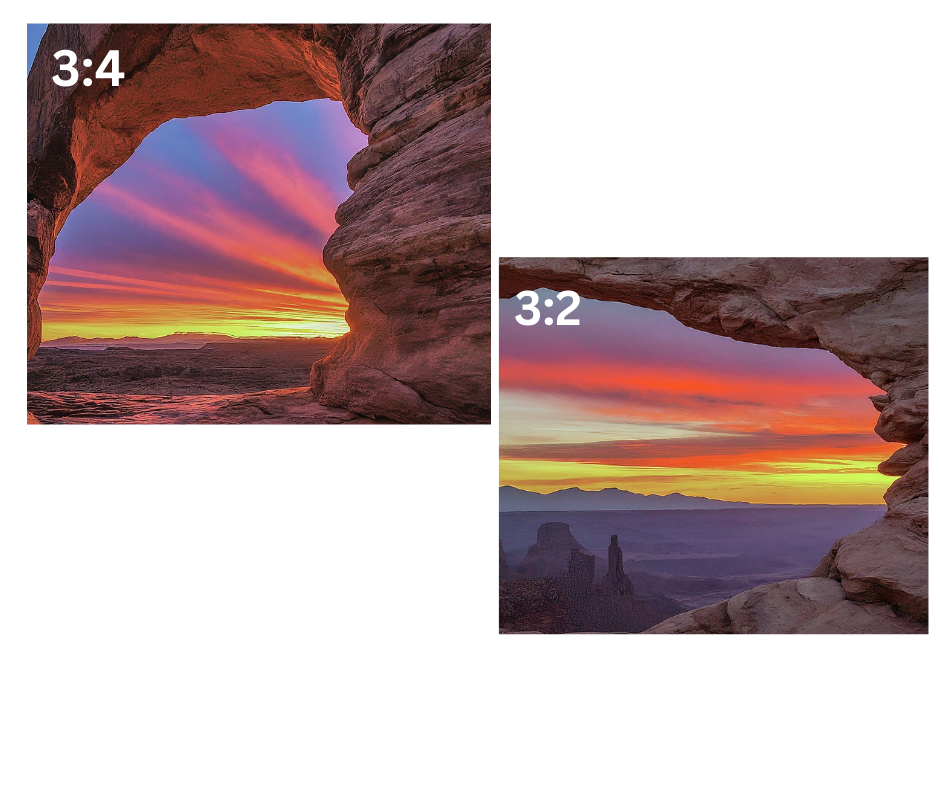Curious about aspect ratios in photography? Wondering how they impact your photos and how you can tweak them after shooting?
In this article, we’ll break down the basics of photography aspect ratios, giving you the know-how to improve your images with this key concept.
Let’s dive right in.
What is a photography aspect ratio?
An aspect ratio is the proportional relationship between an image’s width and height, expressed as a ratio (like 3:2 or 4:5). You’ve probably seen these ratios before, such as 16:9, which is the widescreen format used for many TVs and computer monitors.
For instance, a 16:9 image is 16 units wide and 9 units tall. This ratio describes proportions, not actual size – so 16:9 could mean 16 inches by 9 inches or 16 feet by 9 feet.
Why aspect ratios matter in photography

Your camera’s sensor determines the initial aspect ratio of your images. Because sensor dimensions are fixed, it’s easy to overlook this aspect of photography. However, aspect ratios play a significant role in composition, so it’s worth considering them when you shoot.
Modern camera flexibility
Many modern digital cameras let you change the aspect ratio through the menu. Plus, you can always adjust an image’s aspect ratio during post-processing, providing more creative flexibility than you might expect.
The importance of aspect ratio
Every camera and image has a base aspect ratio, set by the sensor’s proportions, which you can’t change. However, you can adjust the final image’s aspect ratio, often for creative reasons.
There are two primary aspect ratios to consider: the camera’s aspect ratio and the final aspect ratio of the presented image. You can tweak the latter in post-processing to achieve the desired effect.
Creative impacts of different aspect ratios

Different aspect ratios offer distinct compositional effects. For example, a wide shot of a beach looks more expansive in a 16:9 widescreen format compared to a 3:2 standard format. Each aspect ratio has its own advantages and limitations.
A 1:1 aspect ratio often produces balanced, sometimes confined images. A 4:5 or 3:2 ratio offers more room within the frame, while a 16:9 ratio allows for a more expansive view.
Choosing the right aspect ratio depends on your subject. Some scenes naturally fit certain ratios better, so think about aspect ratio choices before pressing the shutter button.
Common camera aspect ratios
3:2 aspect ratio The 3:2 ratio is one of the most common in photography, used by many DSLRs, mirrorless cameras, and 35mm film cameras. This ratio dates back to early 35mm film cameras.
A full-frame 35mm sensor measures 36 mm x 24 mm, simplifying to a 3:2 ratio. Crop-sensor cameras have smaller sensors but maintain the 3:2 ratio.
4:3 aspect ratio The 4:3 ratio is another classic, initially popular in digital point-and-shoot cameras. It matches the proportions of early video monitors and is used in Four Thirds cameras, many compact cameras, and some medium format cameras.
The 4:3 format appears taller and slimmer, making it a good choice for capturing vertical elements.
16:9 aspect ratio The 16:9 widescreen format, developed for HDTV, is now common in TVs and monitors. It’s great for displaying landscapes and creating a cinematic feel in photography.
1:1 ratio The square 1:1 ratio is famous from Instagram but is also standard in medium-format cameras. It’s ideal for close cropping and isolating a subject.
5:4 ratio The 5:4 ratio is used in large-format photography and is great for capturing vertical elements of a scene.
2:3 ratio The 2:3 ratio is used for vertical or portrait orientation, ideal for portraiture and capturing tall elements in landscapes.
Comparing 3:2 and 4:3 aspect ratios
The 3:2 ratio used by most DSLRs and mirrorless cameras is slightly longer than the 4:3 ratio used by Micro Four Thirds cameras. This subtle difference significantly impacts composition, as the longer frame can be more challenging to fill effectively.
More aspect ratio examples

While aspect ratios may seem less impactful in landscape orientation, they become crucial in portrait orientation. A 3:2 frame in portrait mode can be harder to fill, and cropping to a shorter rectangle often improves composition.
Adjusting aspect ratios in-camera
Many digital cameras let you adjust the aspect ratio in the menu. If your camera has an electronic viewfinder, you can see the cropped image in the viewfinder. Otherwise, use Live View to see the cropped image on the rear LCD screen.
Note: Shooting in a non-native aspect ratio in JPEG permanently crops the image. However, shooting in RAW preserves the entire image, allowing you to change the crop in post-processing.
Cropping in post-processing
Cropping in post-processing is often easier and more flexible than adjusting aspect ratio in the field. Programs like Lightroom make cropping straightforward.
Conclusion
Aspect ratio is a crucial element in photography. Consider aspect ratios while shooting and adjust them in post-processing if necessary.
Now, over to you: What’s your favorite aspect ratio? Do you consider aspect ratios while shooting? Share your thoughts in the comments!
Aspect ratio FAQ
Which aspect ratio is best? There is no one-size-fits-all answer; it depends on the look you’re aiming for. Experiment with different aspect ratios in editing programs like Adobe Lightroom to see what works best for your scenes.
What aspect ratio do professional photographers use? It varies. Landscape photographers often favor square ratios like 4:5, while panorama photographers might prefer 16:9 or wider. Portrait photographers typically avoid narrow ratios but sometimes use a 9:16 composition.
What is the aspect ratio of 8×10 photos? 8×10 photos have a 4:5 aspect ratio.
